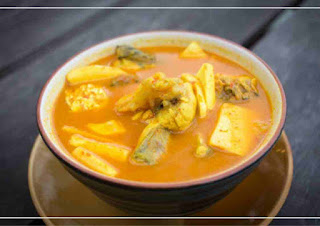Top 10 Traditional Thai food you must try in Thailand
Thailand cuisine is often recognized as among the best in the world. The diversity of Thai cuisine, particularly its world-renowned street food, is remarkable, but it mostly consists of noodles, stir-fries, curries, soups, and salads, which can be found anywhere from mobile food carts to Michelin-starred restaurants in Bangkok. Here are our top must-try Thai dishes for the greatest Thai food.
10 Best Thai Food Dishes You Must Eat
Pad Thai (Stir-Fried Noodles)
 |
| Pad Thai (Stir-Fried Noodles) |
Tom Yum Goong (Hot & Sour Shrimp Soup)
.jpg) |
| Ton Yum Goong |
Kaeng Lueang (Yellow Curry)
 |
| Kaeng lueang |
Thailand's world-famous curries range from mild to explosive, sweet to sour, and always have a soup-like consistency due to the use of coconut milk. There are other regional variations, but the three primary curry types, red, green, and yellow, are the most well-known globally, with variations based on spiciness and dominating ingredients.
Yellow curry has a strong southern Thai flavor, with a rich
texture and distinctive color from the liberal use of turmeric. This is pounded
with traditional fragrant spices like as coriander, cumin, shallots,
lemongrass, and galangal. Coconut milk, carrots, and potatoes are included, as
well as chicken or other protein or tofu choices. Because this curry has less
chilies, it isn't as hot as its green and red curry siblings.so it is more suitable
for children as well.
Gaeng Daeng (Red Curry)
 |
| Gaeng Daeng (Thai red curry) |
Massaman Chicken Curry, one of the most well-known red curry
variants, is mild, sweet, and cooked in coconut milk; yet, it is notable for
its less soupy consistency and interpretation of a classic Persian meal and
Indian curry, created with roasted spices.
Gaeng Keow Wan Gai (Green Curry)
Green curry, which originated in Central Thailand, is the
spiciest of the Thai "holy trinity" and, possibly, the most
well-known worldwide. This immensely popular meal is focused on aromatic green
chilis, which were introduced to Thailand by Portuguese missionaries in the
16th century and give the dish its distinguishing green tint and spicy flavor.
Although it's boiled with coconut milk (which helps to tone things down and
creates a rich, sweet flavor) and contains components seen in many Thai curries
(galangal, shallots, lemongrass, kaffir lime, Thai basil, and so on), it's the
green chilies that make this dish extremely fiery. Green curry is further
distinguished by the presence of small eggplants, potatoes, bamboo shoots, and
chicken breast slivers.
Khao Soi (Thai Coconut Curry Noodle Soup)
Noodle soups are a popular street food dish in Thailand,
available at any time of day or night. Khao Soi (or Soy), a distinctive
Northern Thai cuisine popular in Chiang Mai, is one of the most popular. This
Burmese-inspired soup is famous for its mildly spicy and aromatic curry broth
with a creamy coconut milk base, soft egg noodles, and your choice of chicken,
beef, or tofu, all topped with deep-fried crispy egg noodles, pickled veggies,
and sliced shallots. Khao Soi is wonderful, warming, and somewhat spicy, as
well as sweet and creamy all in one bite.
Khao Pad (Thai Fried Rice)
This Thai fried rice dish is a local favorite that may be
served at any time of day, but especially during lunch. Khao Pad is a Thai dish
prepared with chicken, pig, beef, shellfish, or tofu, as well as eggs, onions,
garlic, fish sauce, fresh herbs, and tomatoes or other vegetables. All of these
ingredients are stir-fried with fragrant Jasmine rice until well combined
before being served with cucumber slices, lime wedges, and other condiments.
Because this very basic recipe can be created to order, you have complete
control over the heat level and other tastes - excellent for picky eaters or
those seeking spicy relief. Khao Pad Sapparod, a pineapple and shrimp version,
is a delectable option.
Pad Kra Pao Moo (Stir-Fried Thai Basil & Pork)
Pad Kra Pao Moo, a famous 'one plate' lunch or supper meal
usually ordered in Thai restaurants, offers a wonderful sweet-spicy mix. Fresh
chilies, garlic, green beans, shallots, fish sauce, palm sugar, and spicy basil
leaves are stir-fried in a blazing hot wok before being heaped over a dish of
steaming white rice and topped with a fried egg. Pork can be replaced with
minced chicken, beef, duck, shellfish, or tofu.
Som Tam (Spicy Green Papaya Salad)
Som Tam, arguably Thailand's best-known salad dish, is said
to have originated in Laos but is now a tasty north-eastern speciality and one
of Thailand's most adored foods. Som Tam comes in a variety of forms and is not
your usual salad. However, the typical recipe calls for shredded green papaya,
red chilies, fish sauce, lime juice, tamarind pulp, and palm sugar, along with
vegetables like cherry tomatoes, carrots, and runner beans, as well as roasted
peanuts and dried shrimp for nutty and crunchy textures. All of them are mashed
in a pestle and mortar, yielding a unique sweet, savory, spicy, salty, and sour
flavor. Regional variants include the inclusion of fermented crab or papaya in
place of mangoes for a completely different flavor depth.
Laab (Spicy Salad)
Khao Niao Mamuang (Mango Sticky Rice)
Mango sticky rice, one of Thailand's most popular traditional sweets, is a great way to end any Thai dinner. This crowd favorite is a simple meal made with sticky rice soaked in coconut milk and slices of fresh mango - lashings of sweetened condensed milk are optional! It is served in the most posh restaurants or street food vendors.

